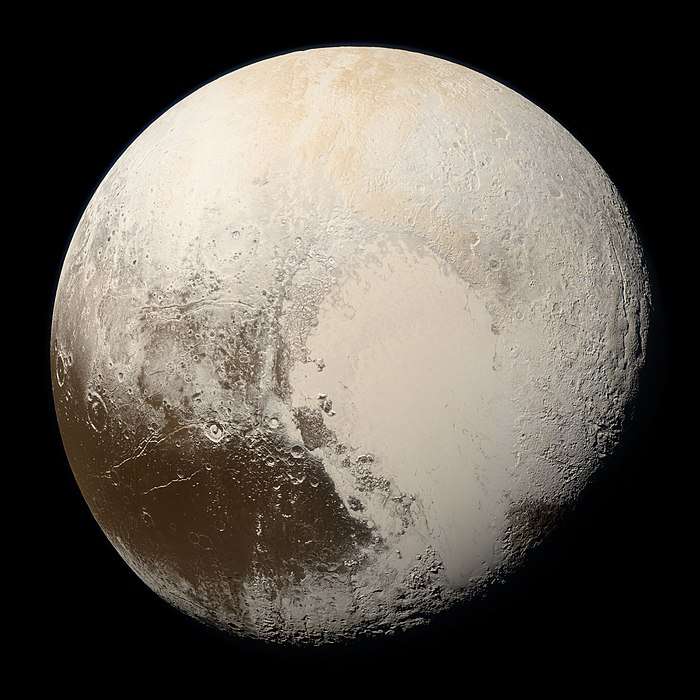(144897) 2004 UX10
(144897) 2004 UX10 is a Kuiper-belt object. It has a diameter of about 360 kilometres (220 mi)[5] and was discovered by Andrew Becker, Andrew Puckett and Jeremy Kubica on 20 October 2004 at Apache Point Observatory in Sunspot, New Mexico.[2] The object is classified as a cubewano.[3][4] It is near a 2:3 resonance with Neptune.[5][7]
| Discovery[1] | |
|---|---|
| Discovered by | A. C. Becker A. W. Puckett J. Kubica |
| Discovery site | Apache Point Obs. |
| Discovery date | 20 October 2004 |
| Designations | |
| (144897) 2004 UX10 | |
| TNO[2] · cubewano[3][4] | |
| Orbital characteristics [2] | |
| Epoch 27 April 2019 (JD 2458600.5) | |
| Uncertainty parameter 2 | |
| Observation arc | 65.21 yr (23,818 days) |
| Aphelion | 40.591 AU |
| Perihelion | 37.152 AU |
| 38.871 AU | |
| Eccentricity | 0.0442 |
| 242.35 yr (88,520 days) | |
| 102.254° | |
| 0° 0m 14.76s / day | |
| Inclination | 9.5316° |
| 147.90° | |
| 149.15° | |
| Physical characteristics | |
| Dimensions | 361+124 −94 km[5] 398±39 km[5][6] |
| Mass | > ≈ 3×1019 kg |
Mean density | > 1.21 g/cm3[7] |
Equatorial surface gravity | > 0.06 m/s2 |
Equatorial escape velocity | > 0.15 km/s |
| 5.68±0.05 h[7] | |
| 0.141+0.044 −0.031[5] | |
| B–V =0.95±0.02 V–R = 0.58±0.05[5] C [6] | |
| 20.6[8] | |
| 4.75±0.16[5] 4.4[2] | |
Brown estimates it is likely a dwarf planet based on its presumed size, calculated from its absolute magnitude (H) and assumed albedo.[9]
Orbit and rotation
Based on an integration of its motion over 10 million years, (144897) 2004 UX10 has been classified as a classical Kuiper belt object (cubewano).[3] It is near a 2:3 resonance with Neptune.[5] The object is currently at 39 AU from the Sun.[8]
The rotational period of (144897) 2004 UX10 is 5.68 h.[2]
Physical properties
The size of (144897) 2004 UX10 was measured by the Herschel Space Telescope to be 361+124
−94 km.[5] The mass of the object is currently unknown but should be greater than about 3×1019 kg.[7]
(144897) 2004 UX10 has a moderately red slope in the visible spectral range. Its visible spectrum does not show any features, although there is a small departure from the linearity near 0.8 μm.[10]
References
- "List Of Transneptunian Objects". Minor Planet Center. Retrieved 22 August 2016.
- "144897 (2004 UX10)". JPL Small-Body Database Browser (2018-10-31 last obs). 13 July 2019. Retrieved 3 November 2019.
- Buie, M. (3 November 2019). "Orbit Fit and Astrometric record for 144897". SwRI (Space Science Department). Archived from the original on 3 November 2019. Retrieved 3 November 2019.
- Johnston, W. R. (13 July 2019). "List of Known Trans-Neptunian Objects". Retrieved 3 November 2019.
- Mommert, Michael; Harris, A. W.; Kiss, C.; Pál, A.; Santos-Sanz, P.; Stansberry, J.; Delsanti, A.; Vilenius, E.; Müller, T. G.; Peixinho, N.; Lellouch, E.; Szalai, N.; Henry, F.; Duffard, R.; Fornasier, S.; Hartogh, P.; Mueller, M.; Ortiz, J. L.; Protopapa, S.; Rengel, M.; Thirouin, A. (May 2012). "TNOs are cool: A survey of the trans-Neptunian region—V. Physical characterization of 18 Plutinos using Herschel-PACS observations". Astronomy & Astrophysics. 541: A93. arXiv:1202.3657. Bibcode:2012A&A...541A..93M. doi:10.1051/0004-6361/201118562.
- "LCDB Data for (144897)". Asteroid Lightcurve Database (LCDB). Retrieved 6 September 2016.
- Thirouin, A.; Ortiz, J. L.; Duffard, R.; Santos-Sanz, P.; Aceituno, F. J.; Morales, N. (2010). "Short-term variability of a sample of 29 trans-Neptunian objects and Centaurs". Astronomy & Astrophysics. 522: A93. arXiv:1004.4841. Bibcode:2010A&A...522A..93T. doi:10.1051/0004-6361/200912340.
- "AstDys (144897) 2004UX10 Ephemerides". Department of Mathematics, University of Pisa, Italy. Retrieved 2012-01-21.
- Michael E. Brown. "How many dwarf planets are there in the outer solar system? (updates daily)". California Institute of Technology. Archived from the original on 2011-10-18. Retrieved 2011-08-25.
- Fornasier, S.; Barucci, M. A.; de Bergh, C.; Alvarez-Candal, A.; Demeo, F.; Merlin, F.; Perna, D.; Guilbert, A.; Delsanti, A.; Dotto, E.; Doressoundiram, A. (2009). "Visible spectroscopy of the new ESO large programme on trans-Neptunian objects and Centaurs: Final results". Astronomy and Astrophysics. 508 (1): 457–465. arXiv:0910.0450. Bibcode:2009A&A...508..457F. doi:10.1051/0004-6361/200912582.
_(cropped).jpg)
